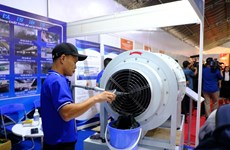Capital flows to major river project in Mekong Delta
Investment capital for the key national-level project to construct a
waterway passage for heavyweight vessels to the Hau River in the Mekong
Delta’s Tra Vinh province has been finalised, the Vietnam Investment
Review reported on January 23.
Investment capital for the key national-level project to construct a
waterway passage for heavyweight vessels to the Hau River in the Mekong
Delta’s Tra Vinh province has been finalised, the Vietnam Investment
Review reported on January 23.
After several years of discussions, the National Assembly Standing Committee last week issued a resolution allocating 6.1 trillion VND (290.47 million USD) as government bond-based capital for the first stage of this 9.781 trillion VND (465.76 million USD) project.
The project initially received government bond-based investment worth 929.3 billion VND (44.25 million USD) for the 2009-2010 period. However, work was delayed in 2010 due to a lack of capital.
Expected to be completed by 2017, this 46.5-kilometre project running through Tra Vinh’s Duyen Hai and Tra Cu districts will allow 10,000-20,000 deadweight tonnage ships to travel on the river.
“The project is crucial and a life-line waterway for economic development of the whole Mekong Delta region,” said Minister of Planning and Investment Bui Quang Vinh, who last week asked the committee to allocate funding to the project.
“The project must be done as soon as possible in order to facilitate the Mekong Delta region’s socio-economic development and attract more investment,” said the National Assembly Vice Chairwoman Tong Thi Phong.
At present, the region’s import-export cargo volume is around 15 million tonnes per year. Its two largest seaports, Can Tho and Cai Cui, are capable of accommodating vessels of only 3,000-5,000 DWT, making the river and seaport systems there capable of handling only 20 percent of the region’s cargo volume.
Up to 80 percent of the region’s exported and imported cargo must go through the ports in Ho Chi Minh City and Ba Ria-Vung Tau province, causing traffic gridlock in these areas. Moreover, the transport distances results in an average 10 USD increase on unloading costs for each tonne of goods.
“It is roughly estimated that if cargo is transported directly on the Hau River, we can save about 10 trillion VND (476.2 million USD) each year until 2020,” Vinh said. “Construction of this project is also vital to the operation of the coal-fired Duyen Hai power centre, because without it, the centre’s port will not be able to receive coal.”
However, some members from the National Assembly’s Finance and Budget Committee who disagreed with the project argued that the project is ineffective because it would not link with the region’s seaport, waterway and expressway planning, and because its investment capital had tripled against the initial estimates.
The project was first approved by the Ministry of Transport in November 2007, with the total investment capital of nearly 3.15 trillion VND (150 million USD). However, in August 2013, the ministry adjusted the project’s details and investment fund, which soared to 9.781 trillion VND (over 465.76 million VND).
Japan’s investment consultancy joint venture PortCoast-Nippon Koei made the budget adjustments.
The ministry in late December 2013 approved the project’s environmental impact assessment report, affirming that the project’s implementation will not adversely affect the environment.-VNA
After several years of discussions, the National Assembly Standing Committee last week issued a resolution allocating 6.1 trillion VND (290.47 million USD) as government bond-based capital for the first stage of this 9.781 trillion VND (465.76 million USD) project.
The project initially received government bond-based investment worth 929.3 billion VND (44.25 million USD) for the 2009-2010 period. However, work was delayed in 2010 due to a lack of capital.
Expected to be completed by 2017, this 46.5-kilometre project running through Tra Vinh’s Duyen Hai and Tra Cu districts will allow 10,000-20,000 deadweight tonnage ships to travel on the river.
“The project is crucial and a life-line waterway for economic development of the whole Mekong Delta region,” said Minister of Planning and Investment Bui Quang Vinh, who last week asked the committee to allocate funding to the project.
“The project must be done as soon as possible in order to facilitate the Mekong Delta region’s socio-economic development and attract more investment,” said the National Assembly Vice Chairwoman Tong Thi Phong.
At present, the region’s import-export cargo volume is around 15 million tonnes per year. Its two largest seaports, Can Tho and Cai Cui, are capable of accommodating vessels of only 3,000-5,000 DWT, making the river and seaport systems there capable of handling only 20 percent of the region’s cargo volume.
Up to 80 percent of the region’s exported and imported cargo must go through the ports in Ho Chi Minh City and Ba Ria-Vung Tau province, causing traffic gridlock in these areas. Moreover, the transport distances results in an average 10 USD increase on unloading costs for each tonne of goods.
“It is roughly estimated that if cargo is transported directly on the Hau River, we can save about 10 trillion VND (476.2 million USD) each year until 2020,” Vinh said. “Construction of this project is also vital to the operation of the coal-fired Duyen Hai power centre, because without it, the centre’s port will not be able to receive coal.”
However, some members from the National Assembly’s Finance and Budget Committee who disagreed with the project argued that the project is ineffective because it would not link with the region’s seaport, waterway and expressway planning, and because its investment capital had tripled against the initial estimates.
The project was first approved by the Ministry of Transport in November 2007, with the total investment capital of nearly 3.15 trillion VND (150 million USD). However, in August 2013, the ministry adjusted the project’s details and investment fund, which soared to 9.781 trillion VND (over 465.76 million VND).
Japan’s investment consultancy joint venture PortCoast-Nippon Koei made the budget adjustments.
The ministry in late December 2013 approved the project’s environmental impact assessment report, affirming that the project’s implementation will not adversely affect the environment.-VNA













